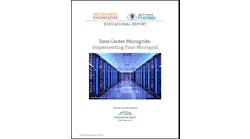Chicago’s much-watched Bronzeville microgrid has scored a key win with an administrative law judge recommending that state regulators okay the Commonwealth Edison project.
Countering objections from the state attorney general, Administrative Law Judge Jessica Cardoni found the plant to be “prudent and reasonable” in a proposed order filed with the Illinois Commerce Commission last week.
The recommendation comes as the microgrid industry awaits a February 28 vote by the commission on one of the largest and most sophisticated utility microgrid projects planned in the U.S. (Case 17-0331).
Ken Horne, energy director for Navigant Consulting, described the administrative law judge’s recommendation as “a big step forward for the industry and a further sign of warming interest toward microgrids as a possible better mousetrap for serving customer distribution needs.”
The Exelon subsidiary seeks cost recovery to build the $29.6 million demonstration microgrid, designed to advance understanding of how microgrids can improve customer service.
The Bronzeville microgrid has captured industry attention as a test case both in terms of technology and regulation.
First, ComEd plans to demonstrate the practice of microgrid clustering – connecting one microgrid to another – a cutting edge approach expected to take hold as more microgrids are developed.
In addition, the proceeding grapples with issues surrounding the utility role in microgrid development, which is largely still undefined in the United States and open to controversy. At issue is who pays for utility microgrids and what part the competitive market plays in their development.
The attorney general’s office opposes ComEd’s plan to recover the Bronzeville microgrid’s costs — $25 million after federal grants are applied. The utility wants to spread the costs among the its 3.9 million customers. The attorney general argues it is unfair for all customers to pay for the microgrid, saying the facility will only directly service 1,060 customers.
Join Microgrid Knowledge in Chicago for Microgrid 2018, May 7-9.
But the administrative law judge disagreed, arguing that lessons learned from the test microgrid will benefit all of ComEd’s 3.9 million customers, as well as others in Illinois and across the country.”
Information derived from the Bronzeville microgrid “will benefit every customer that takes electric delivery service in an increasingly complicated distribution-system environment,” Cardoni wrote.
Warming toward Bronzeville microgrid
The proceeding has drawn the attention of a range of energy players, who have weighed in before the commission. Some who argued against the Bronzeville microgrid early in the proceeding have since softened their position based on modifications to the plan made by ComEd.
The Environmental Defense Fund and Citizens Utility Board, an Illinois consumer group, are among those who now back the Bronzeville microgrid. The two organizations withdrew objections after ComEd agreed to work with them during Bronzeville’s second phase to develop a pilot tariff for microgrid services. The tariff would allow non-utility third parties to develop and manage microgrids.
ComEd also won their backing after prioritizing the project’s study of renewable integration onto the distribution grid.
The Illinois Competitive Energy Association, which represents competitive retail suppliers, also said it can support the project if the utility adopts certain competitive bidding and procurement procedures. Among other things, the association wants the utility to treat energy storage as it would generation – bidding for it competitively and allowing third party ownership.
Because Illinois is a restructured state, limits exist on the utility’s ability to own generation. In keeping with restructuring rules, ComEd has agreed to go out to bid for the microgrid’s distributed energy and allow it to be owned by a third party. If the utility receives no bids, or they are too high, it will lease the generation assets.
The utility opposes the idea of allowing a third party to own energy storage, arguing that the batteries will act as an integrated device on the distribution grid that it must control. Cardoni upheld ComEd’s position in the proposed order.
The Bronzeville microgrid still faces push back from the staff of the commission, which objects to its size and recommends a smaller scale demonstration that would reduce the price by $12.3 million.
Visionary in a deeply regulated industry
Anne Pramaggiore, ComEd president and CEO, speaking at Microgrid 2017
Navigant’s Horne said the administrative law judge’s proposed order “really feels like a shot in the arm for utility distribution innovation.” He described ComEd as “out in front of many of its peer utilities in articulating a vision of the future grid that contains microgrids at its center” – a position not easy for utilities. “It’s hard to be a visionary in a deeply regulated industry where risk aversion is a constant drag on risk-taking innovation.”
The Bronzeville microgrid is expected to test microgrid technology over a wide variety of customers including single-family residential, multi-family residential, and nonresidential customers.
ComEd sought commission approval of the Bronzeville microgrid in July, after project funding failed to make it into a larger energy bill passed by the state legislature in 2016.
Quick Facts about the Bronzeville Microgrid
- 1,060 residential, commercial, and small industrial customers directly served
- 7 MW aggregate load
- Critical public service customers: De La Salle Institute; the Perspectives/Illinois Institute of Technology Math & Science Academy; the Chicago Bee Public Library; Kensington Place Nursing and Rehabilitation Center; Illinois College of Optometry; Symphony of Bronzeville Skilled Nursing and Living Center; Chicago Military Academy at Bronzeville; Heartland Human Care Services; and the Public Safety Headquarters of the City of Chicago
- Phase I – 2.5 MW load, solar PV and battery storage, diesel back-up
- Phase II – 4.5 MW load, 7-MW of controllable generation (possibility natural gas). Clustering demonstration with existing microgrid at the Illinois Institute of Technology
- Cost: Total $25 million. Includes $14.7 million for generation and $11.3 million for distribution upgrades
- Contributions: $4 million DOE grant; $600,000 from partner
Track news about the Bronzeville microgrid. Subscribe to the free Microgrid Knowledge newsletter.







